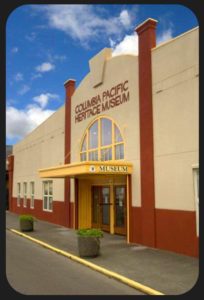In order to maintain the rolling stock, there were turntables, siding tracks, and water tanks at Ilwaco, Megler, and Nahcotta. An additional water tower was located at Holman as well. There were engine houses at Ilwaco and Nahcotta, and a maintenance shed in Nahcotta, where repairs to cars and locomotives took place.
The IR&N initially laid used, 35 lbs track that is to be considered lightweight track. When the railroad sold, the new owners replaced much of the rail with heavier duty track, and the ties were replaced with longer ties as the new owners looked toward future plans that did not materialize. Occasionally, the railroad was asked by the municipalities to “plank in” the tracks to provide safer, cleaner options for pedestrians and drivers on the streets they shared.
Passenger and freight service began with platforms built on the ground at appropriate stopping areas. As services increased and with the need to conduct railroad business, depots with offices, waiting rooms, freight areas and platforms were constructed at strategic locations. There were several “waiting stations” in the smaller communities, and at several hotels. These were often just platforms, and occasionally with a roof. In 1913, the railroad built a temporary platform and plank sidewalk so passengers could depart the trains to view a beached 47’ whale.
Operating by tide tables at the wharf in Ilwaco was restricting the efficiency of railroad operations. With a deeper water access available to the east of Point Ellice, a plan was made to establish a newer, larger wharf there. The area between Ilwaco and Fort Columbia was swampy, and to avoid local navigable waterways which would require drawbridges, the route was created from a wye junction at the northwest corner of Black Lake going east, and along an area roughly defined by present day upper Chinook Valley Road. This route through wetlands required 16 to 18 railway trestles. And, at Ft. Columbia, a tunnel was built. The new wharf in Megler had electrical lighting, and was said to be “spectacular at night”.
During the construction of the tunnel under Fort Columbia on Scarborough Hill, material was removed from the hillside and deposited to the east of Scarborough Hill forming a causeway for the rail bed going towards McGowan. The work was interrupted by a labor issue and a recession in November of 1907. The approximately 80 workers finished the tunnel project in February of 1908. The tunnel was lined with timbers and the portals were wooden as well. The tunnel you drive through today is about 74′ shorter, much wider, and taller as well. Now, the cement lined tunnel was given its second life as an automobile tunnel.
Infrastructure Operating Locations:
| WHARFS | Ilwaco Nahcotta Megler |
| TURNTABLES | Ilwaco Nahcotta Megler |
| MAINTENANCE SHED | Nahcotta |
| WATER TOWERS | Ilwaco Holman Nahcotta Megler |
| TRESTLES | Multiple locations |
| TUNNEL | Under Ft. Columbia |
| FREIGHT DEPOT | Ilwaco |
| PASSENGER DEPOTS | Ilwaco Seaview Long Beach Ocean Park Nahcotta Chinook Ft Columbia Megler |
| WAITING STATIONS | Holman Shelborne Beach Center Newton Tioga Breakers Cranberry Oceanside Klipsan Ilwaco Junction Ellis McGowan |
